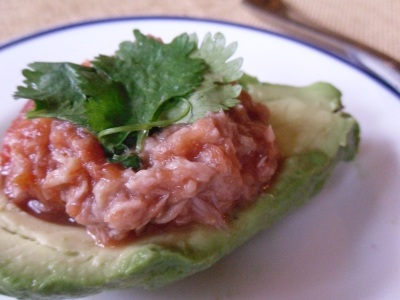
Tempura style veggies are still veggies, right? Read on to learn how to make the most of healthy sushi dining without breaking your diet.
What’s the healthiest thing you can order at a sushi restaurant?
Mmmm sushi… fresh fish, sea vegetables, beautiful presentation, and thanks to Groupon, this luxury food can cost no more than any other dinner out. And it’s all healthy, right?
Not quite. If you are looking for a light dinner, “it’s just fish” doesn’t quite sum up a meal of fried, breaded (tempura) sea life, cream cheese stacked Philadelphia rolls, sodium spiked soy sauce, and hidden high-cal spicy mayo. Want to have your maki and eat it too? Here are some tips for smooth sailing for a healthy sushi dinner.
Appetizers
A cup of hot green tea is a great way to start your meal, delivering antioxidants warmth and flavor without any sugar or calories. Edamame, shelled soybeans, are high in protein and low in calories. While they are not low in sodium, seaweed salad and miso soup are two great sushi starters. Seaweed salad is rich in nutrients, high in flavor, and low in calories. Miso soup will help fill you up on fewer calories and delivers some tasty tofu and kelp to get the meal started well. Avoid fried appetizers which will add fat and calories at the start of the meal without staving off hunger.
Sushi Rolls
Special rolls, the ones with imaginative names, are often more caloric than the basic rolls due to added sauces or “crunchy” fried elements. Salmon, octopus (tako), fresh water eel, salt water eel, shrimp, crab, scallops, smelt eggs (smelt roe), and trout are all low mercury fish. Choose these fish more often to reduce toxic effects of bio-accumulation. Eat less of high mercury fish like yellow fin (ahi), yellowtail and other sushi-grade tunas, swordfish, mackerel, and sea bass. As far as calories go, salmon, roe, trout, shrimp, squid, and scallops served as sushi, tend to be lighter among the lower mercury options.
Vegetable rolls, salmon rolls, and combination rolls without tempura or heavy sauces a great picks. While eel and avocado are not low in calories or fat, they are also nutritious and I consider them worth the calories for the flavors they provide. My strategy: order these and enjoy them but don’t get them in every roll. If, like me, you love avocado,order one roll or two rolls that contain it and get low-cal veggies like cucumber slices or shredded carrots in the rest. You can ask to add these or other veggies to a roll even if it doesn’t normally come that way. Stick to one roll or a couple of pieces of sashimi with your favorite caloric or higher mercury fish. Make your favorites part of the meal, just know which dishes can add up to big calories so you can keep them paired with lighter fare.
More Ordering Tips
Choose It: Brown rice, rice-less options, reduced sodium soy sauce, wasabi, ginger.
Choose brown rice when it’s offered for more nutrients and fiber. At most restaurants you will hardly be able to taste a difference but the choice is better nutritionally. (My one exception to this is at supermarkets. I have yet to find a grocery store that makes brown rice sushi that tastes good. If you know of one please leave a comment and share it!) Or, just go rice-less: Many restaurants serve rice-less alternatives. When I was in NYC last weekend I had a great salmon avocado roll, wrapped in cucumber instead of rice. It was very fresh and a nice addition to the meal. Traditional sushi, or raw fish, is often served by itself sans rice.
Skip It: Tempura, regular soy sauce, cream cheese, caloric drinks, and lots of spicy mayo.
As much as I love “spicy” rolls, I try to stick to one roll like this at the most per meal as these are made with caloric spicy mayo. Instead, make your roll spicy by loading up on wasabi, which contains some natural anti-bacterial properties.
References
Natural Resources Defense Council Guide to Mercury in Sushi
FDA Mercury Levels in Commercial Fish & Shellfish
US EPA What You Need to Know about Mercury in Fish and Shellfish





